HONDA FIT 2010 2.G Workshop Manual
Manufacturer: HONDA, Model Year: 2010, Model line: FIT, Model: HONDA FIT 2010 2.GPages: 351, PDF Size: 5.67 MB
Page 51 of 351
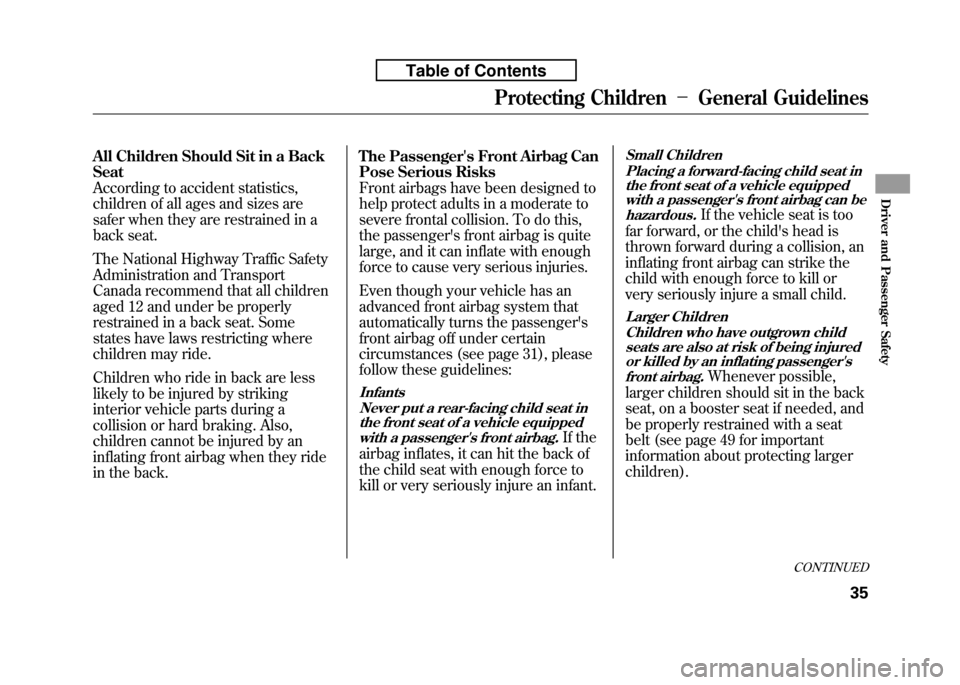
All Children Should Sit in a Back Seat
According to accident statistics,
children of all ages and sizes are
safer when they are restrained in a
back seat.
The National Highway Traffic Safety
Administration and Transport
Canada recommend that all children
aged 12 and under be properly
restrained in a back seat. Some
states have laws restricting where
children may ride.
Children who ride in back are less
likely to be injured by striking
interior vehicle parts during a
collision or hard braking. Also,
children cannot be injured by an
inflating front airbag when they ride
in the back.The Passenger's Front Airbag Can
Pose Serious Risks
Front airbags have been designed to
help protect adults in a moderate to
severe frontal collision. To do this,
the passenger's front airbag is quite
large, and it can inflate with enough
force to cause very serious injuries.
Even though your vehicle has an
advanced front airbag system that
automatically turns the passenger's
front airbag off under certain
circumstances (see page 31), please
follow these guidelines:
Infants
Never put a rear-facing child seat inthe front seat of a vehicle equipped
with a passenger's front airbag.
If the
airbag inflates, it can hit the back of
the child seat with enough force to
kill or very seriously injure an infant.
Small Children
Placing a forward-facing child seat inthe front seat of a vehicle equippedwith a passenger's front airbag can be
hazardous.
If the vehicle seat is too
far forward, or the child's head is
thrown forward during a collision, an
inflating front airbag can strike the
child with enough force to kill or
very seriously injure a small child.
Larger Children
Children who have outgrown childseats are also at risk of being injuredor killed by an inflating passenger's
front airbag.
Whenever possible,
larger children should sit in the back
seat, on a booster seat if needed, and
be properly restrained with a seat
belt (see page 49 for important
information about protecting largerchildren).
CONTINUED
Protecting Children -General Guidelines
35
Driver and Passenger Safety
Table of Contents
Page 52 of 351
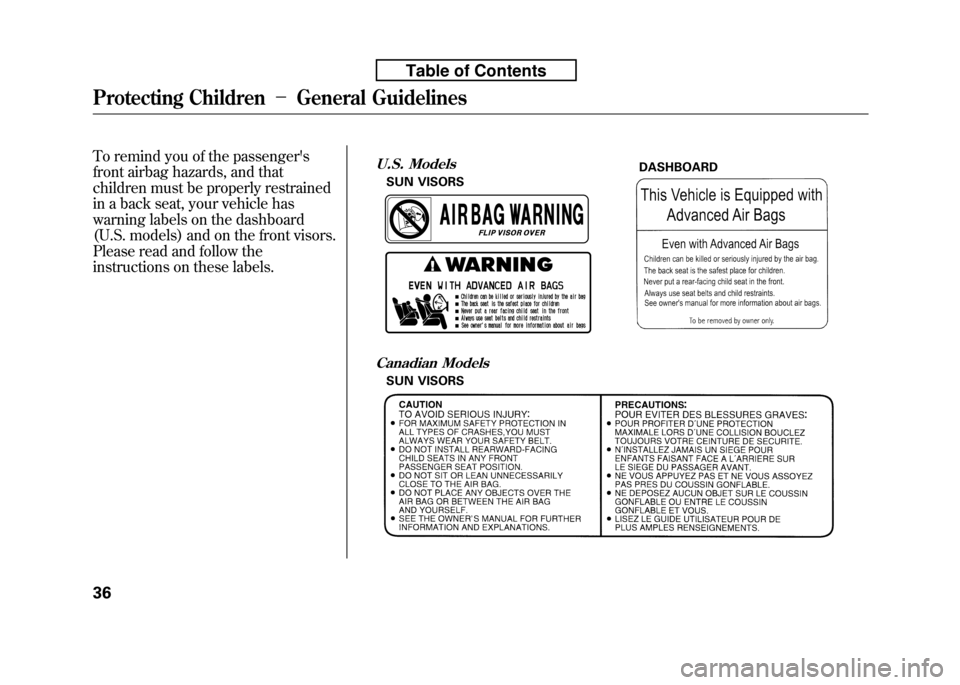
To remind you of the passenger's
front airbag hazards, and that
children must be properly restrained
in a back seat, your vehicle has
warning labels on the dashboard
(U.S. models) and on the front visors.
Please read and follow the
instructions on these labels.U.S. ModelsDASHBOARD
SUN VISORS
Canadian Models
SUN VISORS
Protecting Children -General Guidelines
36
Table of Contents
Page 53 of 351
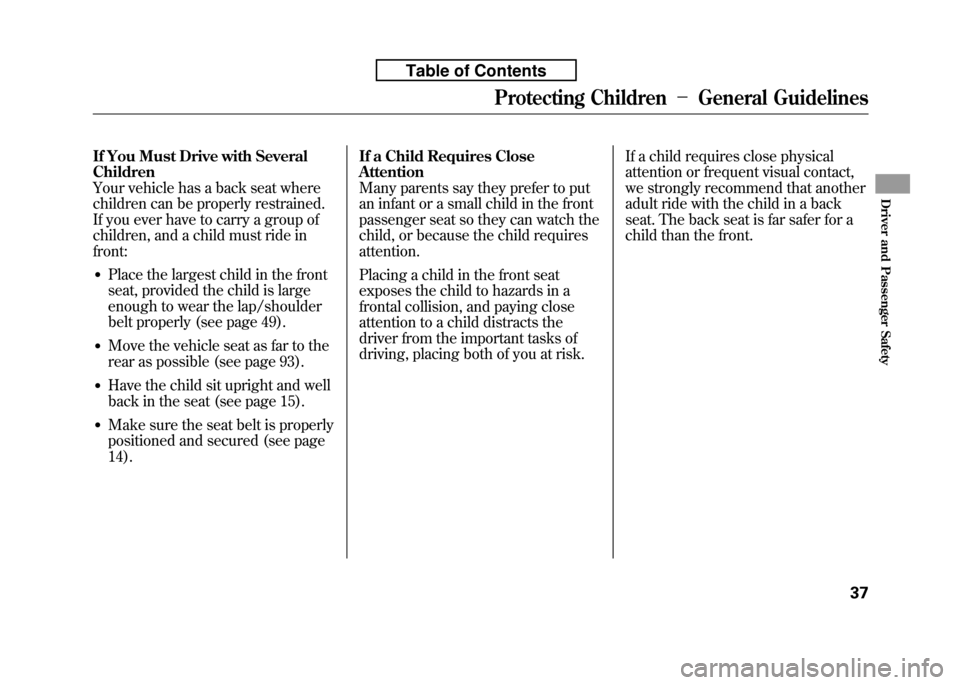
If You Must Drive with Several Children
Your vehicle has a back seat where
children can be properly restrained.
If you ever have to carry a group of
children, and a child must ride infront:● Place the largest child in the front
seat, provided the child is large
enough to wear the lap/shoulder
belt properly (see page 49).
● Move the vehicle seat as far to the
rear as possible (see page 93).
● Have the child sit upright and well
back in the seat (see page 15).
● Make sure the seat belt is properly
positioned and secured (see page14). If a Child Requires CloseAttention
Many parents say they prefer to put
an infant or a small child in the front
passenger seat so they can watch the
child, or because the child requiresattention.
Placing a child in the front seat
exposes the child to hazards in a
frontal collision, and paying close
attention to a child distracts the
driver from the important tasks of
driving, placing both of you at risk.
If a child requires close physical
attention or frequent visual contact,
we strongly recommend that another
adult ride with the child in a back
seat. The back seat is far safer for a
child than the front.
Protecting Children
-General Guidelines
37
Driver and Passenger Safety
Table of Contents
Page 54 of 351
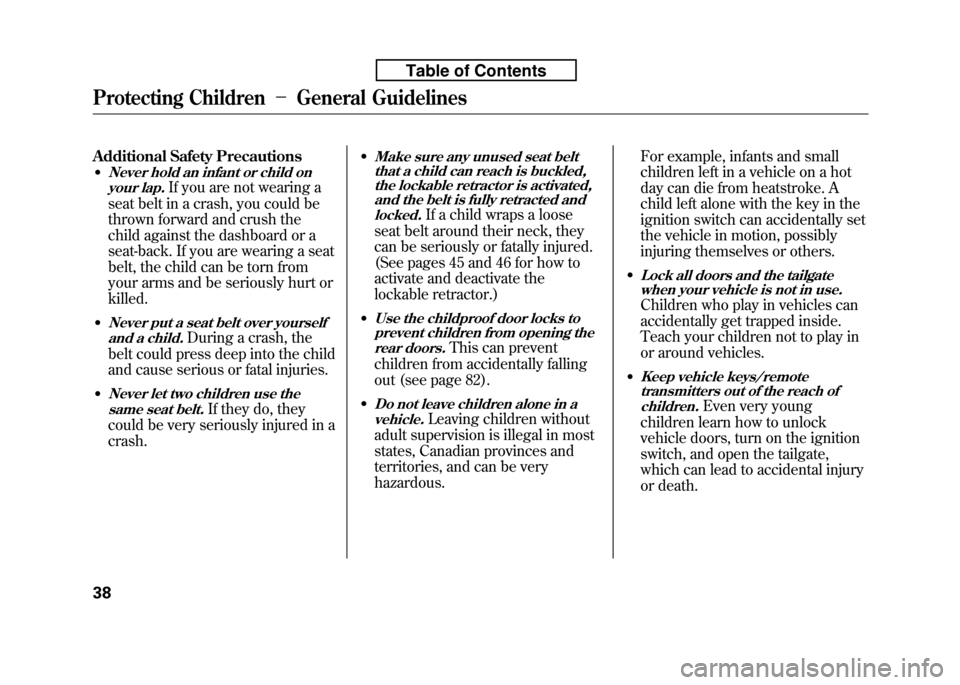
Additional Safety Precautions●
Never hold an infant or child on
your lap.
If you are not wearing a
seat belt in a crash, you could be
thrown forward and crush the
child against the dashboard or a
seat-back. If you are wearing a seat
belt, the child can be torn from
your arms and be seriously hurt orkilled.
●
Never put a seat belt over yourself and a child.
During a crash, the
belt could press deep into the child
and cause serious or fatal injuries.
●
Never let two children use the same seat belt.
If they do, they
could be very seriously injured in acrash. ●
Make sure any unused seat belt
that a child can reach is buckled,
the lockable retractor is activated,and the belt is fully retracted and
locked.
If a child wraps a loose
seat belt around their neck, they
can be seriously or fatally injured.
(See pages 45 and 46 for how to
activate and deactivate the
lockable retractor.)
●
Use the childproof door locks to prevent children from opening the
rear doors.
This can prevent
children from accidentally falling
out (see page 82).
●
Do not leave children alone in a vehicle.
Leaving children without
adult supervision is illegal in most
states, Canadian provinces and
territories, and can be veryhazardous. For example, infants and small
children left in a vehicle on a hot
day can die from heatstroke. A
child left alone with the key in the
ignition switch can accidentally set
the vehicle in motion, possibly
injuring themselves or others.
●
Lock all doors and the tailgate when your vehicle is not in use.
Children who play in vehicles can
accidentally get trapped inside.
Teach your children not to play in
or around vehicles.
●
Keep vehicle keys/remote transmitters out of the reach of
children.
Even very young
children learn how to unlock
vehicle doors, turn on the ignition
switch, and open the tailgate,
which can lead to accidental injury
or death.
Protecting Children -General Guidelines
38
Table of Contents
Page 55 of 351
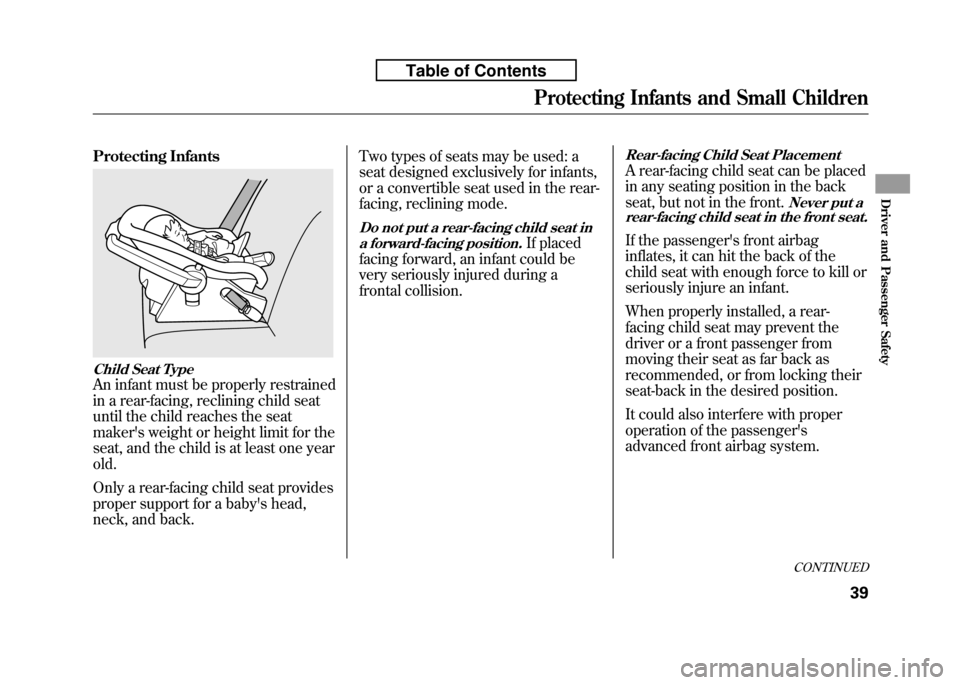
Protecting Infants
Child Seat Type
An infant must be properly restrained
in a rear-facing, reclining child seat
until the child reaches the seat
maker's weight or height limit for the
seat, and the child is at least one yearold.
Only a rear-facing child seat provides
proper support for a baby's head,
neck, and back.Two types of seats may be used: a
seat designed exclusively for infants,
or a convertible seat used in the rear-
facing, reclining mode.
Do not put a rear-facing child seat in
a forward-facing position.
If placed
facing forward, an infant could be
very seriously injured during a
frontal collision.
Rear-facing Child Seat Placement
A rear-facing child seat can be placed
in any seating position in the back
seat, but not in the front.
Never put a
rear-facing child seat in the front seat.
If the passenger's front airbag
inflates, it can hit the back of the
child seat with enough force to kill or
seriously injure an infant.
When properly installed, a rear-
facing child seat may prevent the
driver or a front passenger from
moving their seat as far back as
recommended, or from locking their
seat-back in the desired position.
It could also interfere with proper
operation of the passenger's
advanced front airbag system.
CONTINUED
Protecting Infants and Small Children
39
Driver and Passenger Safety
Table of Contents
Page 56 of 351
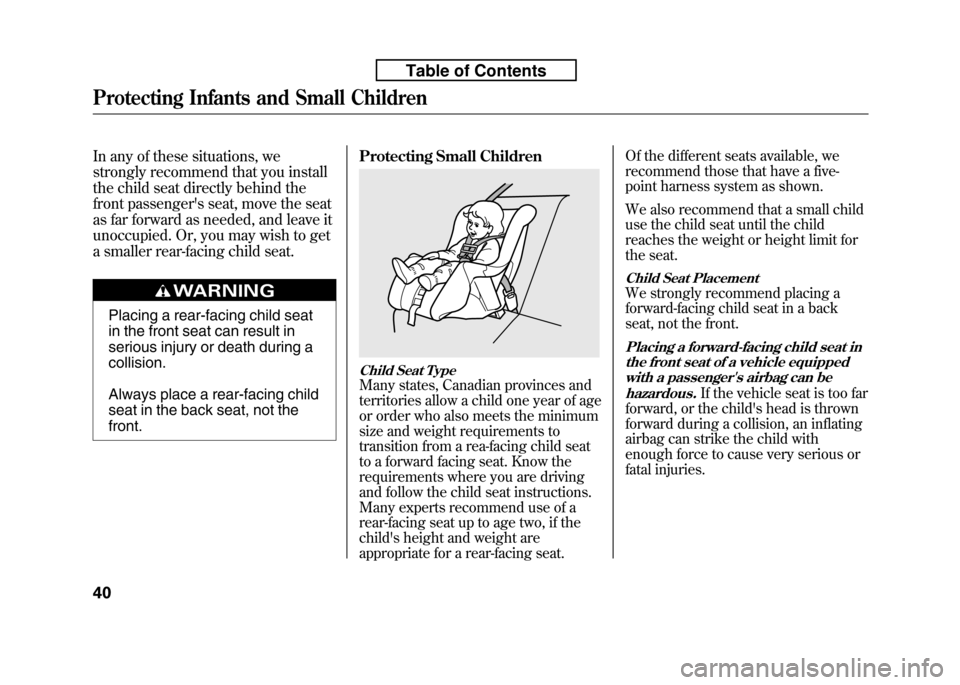
In any of these situations, we
strongly recommend that you install
the child seat directly behind the
front passenger's seat, move the seat
as far forward as needed, and leave it
unoccupied. Or, you may wish to get
a smaller rear-facing child seat.
Placing a rear-facing child seat
in the front seat can result in
serious injury or death during acollision.
Always place a rear-facing child
seat in the back seat, not thefront.Protecting Small Children
Child Seat Type
Many states, Canadian provinces and
territories allow a child one year of age
or order who also meets the minimum
size and weight requirements to
transition from a rea-facing child seat
to a forward facing seat. Know the
requirements where you are driving
and follow the child seat instructions.
Many experts recommend use of a
rear-facing seat up to age two, if the
child's height and weight are
appropriate for a rear-facing seat. Of the different seats available, we
recommend those that have a five-
point harness system as shown.
We also recommend that a small child
use the child seat until the child
reaches the weight or height limit for
the seat.
Child Seat Placement
We strongly recommend placing a
forward-facing child seat in a back
seat, not the front.
Placing a forward-facing child seat in
the front seat of a vehicle equipped
with a passenger's airbag can be
hazardous.
If the vehicle seat is too far
forward, or the child's head is thrown
forward during a collision, an inflating
airbag can strike the child with
enough force to cause very serious or
fatal injuries.
Protecting Infants and Small Children
40
Table of Contents
Page 57 of 351
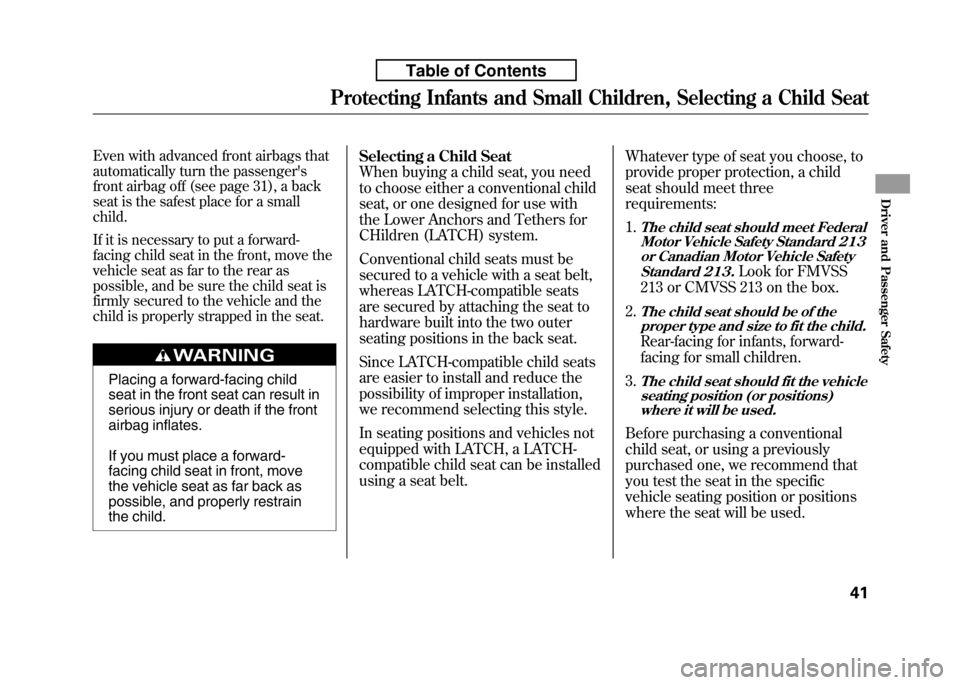
Even with advanced front airbags that
automatically turn the passenger's
front airbag off (see page 31), a back
seat is the safest place for a small child.
If it is necessary to put a forward-
facing child seat in the front, move the
vehicle seat as far to the rear as
possible, and be sure the child seat is
firmly secured to the vehicle and the
child is properly strapped in the seat.
Placing a forward-facing child
seat in the front seat can result in
serious injury or death if the front
airbag inflates.
If you must place a forward-
facing child seat in front, move
the vehicle seat as far back as
possible, and properly restrain
the child.Selecting a Child Seat
When buying a child seat, you need
to choose either a conventional child
seat, or one designed for use with
the Lower Anchors and Tethers for
CHildren (LATCH) system.
Conventional child seats must be
secured to a vehicle with a seat belt,
whereas LATCH-compatible seats
are secured by attaching the seat to
hardware built into the two outer
seating positions in the back seat.
Since LATCH-compatible child seats
are easier to install and reduce the
possibility of improper installation,
we recommend selecting this style.
In seating positions and vehicles not
equipped with LATCH, a LATCH-
compatible child seat can be installed
using a seat belt.
Whatever type of seat you choose, to
provide proper protection, a child
seat should meet threerequirements: 1.
The child seat should meet Federal
Motor Vehicle Safety Standard 213
or Canadian Motor Vehicle Safety
Standard 213.
Look for FMVSS
213 or CMVSS 213 on the box.
2.
The child seat should be of the proper type and size to fit the child.
Rear-facing for infants, forward-
facing for small children.
3.
The child seat should fit the vehicle seating position (or positions)where it will be used.
Before purchasing a conventional
child seat, or using a previously
purchased one, we recommend that
you test the seat in the specific
vehicle seating position or positions
where the seat will be used.
Protecting Infants and Small Children, Selecting a Child Seat
41
Driver and Passenger Safety
Table of Contents
Page 58 of 351
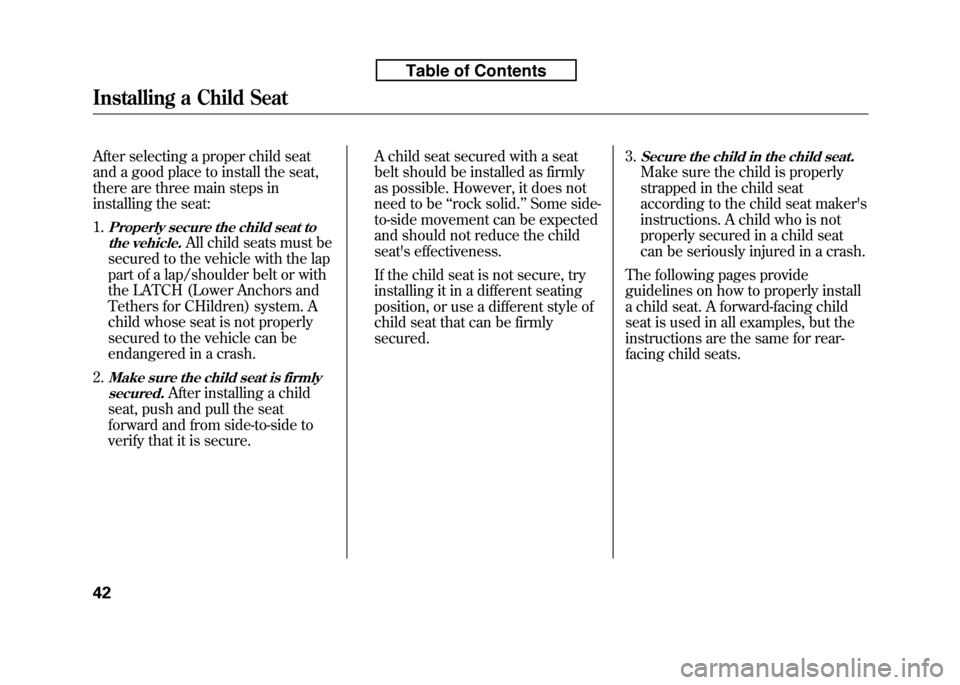
After selecting a proper child seat
and a good place to install the seat,
there are three main steps in
installing the seat: 1.
Properly secure the child seat tothe vehicle.
All child seats must be
secured to the vehicle with the lap
part of a lap/shoulder belt or with
the LATCH (Lower Anchors and
Tethers for CHildren) system. A
child whose seat is not properly
secured to the vehicle can be
endangered in a crash.
2.
Make sure the child seat is firmly secured.
After installing a child
seat, push and pull the seat
forward and from side-to-side to
verify that it is secure. A child seat secured with a seat
belt should be installed as firmly
as possible. However, it does not
need to be
‘‘rock solid. ’’Some side-
to-side movement can be expected
and should not reduce the child
seat's effectiveness.
If the child seat is not secure, try
installing it in a different seating
position, or use a different style of
child seat that can be firmlysecured. 3.
Secure the child in the child seat.
Make sure the child is properly
strapped in the child seat
according to the child seat maker's
instructions. A child who is not
properly secured in a child seat
can be seriously injured in a crash.
The following pages provide
guidelines on how to properly install
a child seat. A forward-facing child
seat is used in all examples, but the
instructions are the same for rear-
facing child seats.
Installing a Child Seat
42
Table of Contents
Page 59 of 351
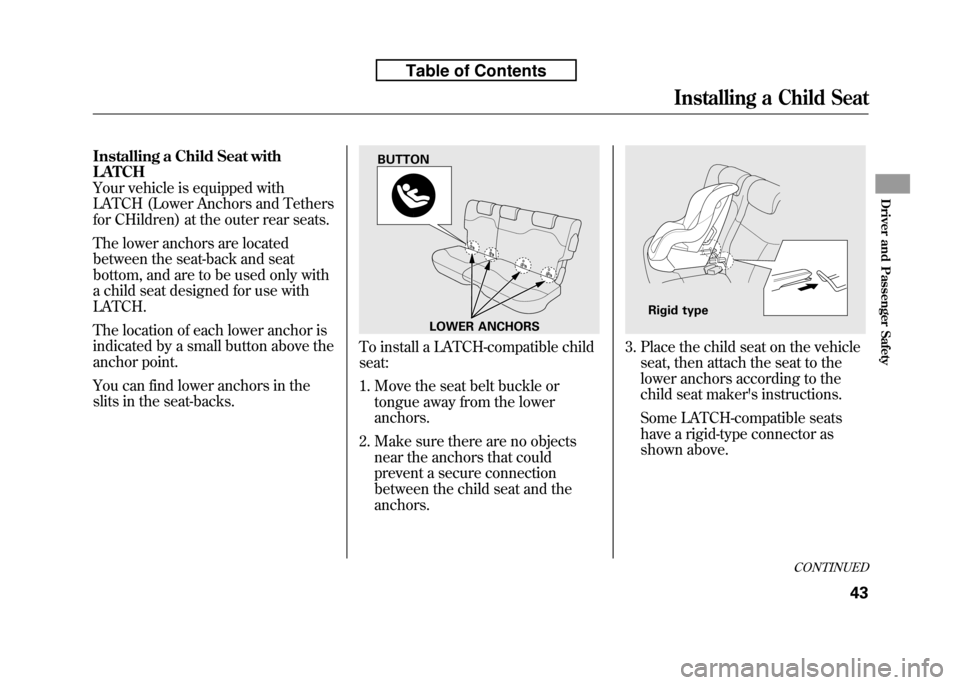
Installing a Child Seat with LATCH
Your vehicle is equipped with
LATCH (Lower Anchors and Tethers
for CHildren) at the outer rear seats.
The lower anchors are located
between the seat-back and seat
bottom, and are to be used only with
a child seat designed for use withLATCH.
The location of each lower anchor is
indicated by a small button above the
anchor point.
You can find lower anchors in the
slits in the seat-backs.
To install a LATCH-compatible child seat:
1. Move the seat belt buckle ortongue away from the lower anchors.
2. Make sure there are no objects near the anchors that could
prevent a secure connection
between the child seat and the anchors.3. Place the child seat on the vehicleseat, then attach the seat to the
lower anchors according to the
child seat maker's instructions.
Some LATCH-compatible seats
have a rigid-type connector as
shown above.
LOWER ANCHORS
BUTTON
Rigid type
CONTINUED
Installing a Child Seat
43
Driver and Passenger Safety
Table of Contents
Page 60 of 351
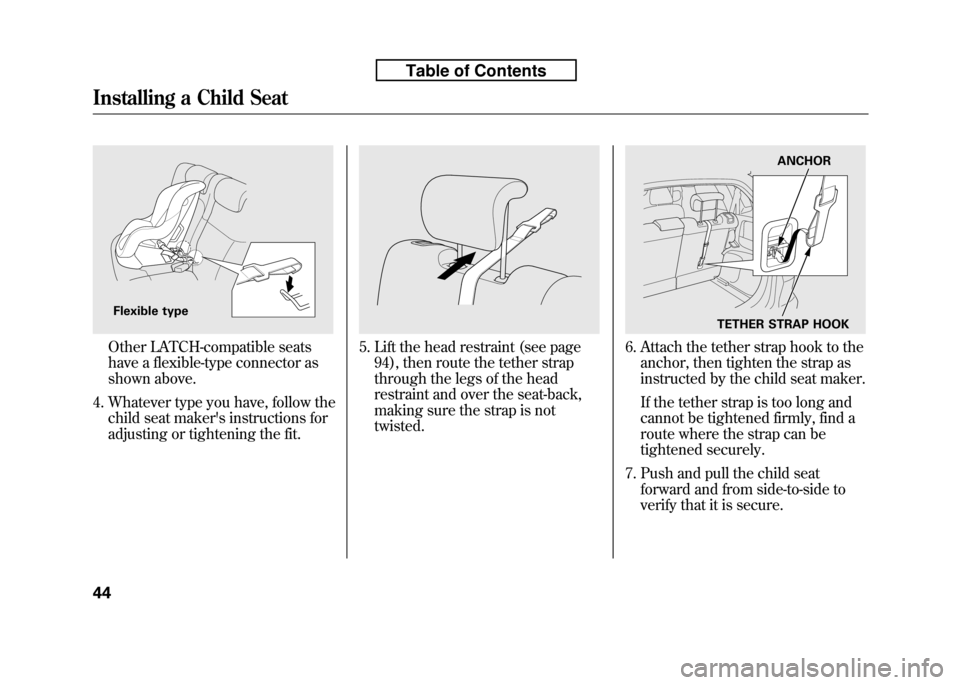
Other LATCH-compatible seats
have a flexible-type connector as
shown above.
4. Whatever type you have, follow the child seat maker's instructions for
adjusting or tightening the fit.5. Lift the head restraint (see page94), then route the tether strap
through the legs of the head
restraint and over the seat-back,
making sure the strap is nottwisted.6. Attach the tether strap hook to theanchor, then tighten the strap as
instructed by the child seat maker.
If the tether strap is too long and
cannot be tightened firmly, find a
route where the strap can be
tightened securely.
7. Push and pull the child seat forward and from side-to-side to
verify that it is secure.
Flexible type
ANCHOR
TETHER STRAP HOOK
Installing a Child Seat
44
Table of Contents